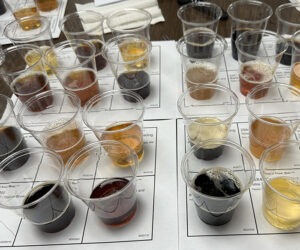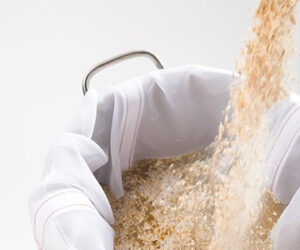Troubleshooting Homebrew Techniques
One of the nice things about homebrewing is that it is fairly forgiving. Most small errors do not usually result in disaster. Still, it does happen that a homebrewer will hit a stretch when his (or her) beers aren’t turning out as they should. If you brew more than a couple bad beers in a row, after having brewed successfully before, this can be very discouraging. The good news is, if you brewed good beer before, you can do it again — you just need to identify and correct the problem. In this article, I’ll tell you how to troubleshoot your brews and get your brewing mojo back.
What not to do
Before I get to steps you should take, let me review the things you should avoid. The first is getting discouraged. As I said, if you brewed good beer before, you can do it again. And, if you troubleshoot your way to the problem, you’ll feel even better knowing that not only has your beer returned to form, but you’ve also identified the problem and can avoid it in the future.
The second thing to avoid is changing everything you can in your recipes or brewing procedures. If you hit a rough patch, it’s understandable that you may consider completely revamping your brewing practices. With the wealth of information available from homebrew club members, online forums, books and magazines, you may consider trying out some new recipes or techniques — after all, your old ways quit working, right?
This is actually a bad idea for a few reasons. The first is, if you brewed good beer before, your old ways did work. You just need to find the new monkey wrench in the machine.
Secondly, if you try three or four new things in a batch of beer, your new procedures may cause you new unforeseen problems. Then you will have multiple problems to root out. Don’t troubleshoot like Dick Cheney hunts, blasting away at everything that moves. Try to focus on a single target.
The one exception to this rule is if you were ignoring sound brewing fundamentals. If your old way of brewing involved, say, both underpitching and taking chances with sanitation, you should correct both of those things the next time you brew.
Finally, don’t take the opposite approach, simply brewing and rebrewing your failed beers without changing anything. If your beers went from good to bad, there is a reason; and the odds that that reason will simply disappear are fairly low.
Looking for trouble
Troubleshooting is really just applied common sense. If something has gone wrong in a machine, you would simply test each part of the machine until you found the problem. In many cases, the problem itself may suggest which part to test first. (If you turn the ignition key on your car and nothing happens, you’re more likely to find the problem if you check the battery rather than your tire pressure.) Most homebrew books have a troubleshooting table that lists common problems and their most likely causes. (There is also a table compiled to accompany this piece online at www.byo.com.) If your problem can be found on one of these charts, you can stand on the shoulders of giants — or slightly overweight middle-aged homebrewers (like myself) — and have the most likely cause of your problem pointed out to you. If this doesn’t solve your problem, read on for the general approach to troubleshooting problems in your homebrew by yourself.
Attention newbies
The first thing to do whenever you suspect you have a bad batch of beer is to give it time. Never dump a batch because something smells, tastes or looks funny during fermentation or conditioning. Fermentation can generate a lot of unpleasant smells and green beer often has an unpleasant taste. What looks like mold or contamination may just be what a certain strain of brewers yeast looks like. New brewers are often too quick to pull the plug on a batch when it is simply going through the normal progress of fermentation and conditioning.
If your beer has carbonated and has been in the fridge for a couple weeks and it still tastes bad — or is getting progressively worse — then it is time to figure out what the problem is.
Troubleshooting on your own
If you can’t find your problem on any chart, you’ll have to ferret it out yourself. The first step in doing this is to try to identify everything that was different between your bad batches of beer and previous good batches. Sometimes, the differences are obvious — maybe you just moved and you know your water is harder or softer than you were used to. Maybe you tried out a new procedure, ingredient or processing agent.
Sometimes, though, the differences may be harder to find. Maybe the city switched wells or its water treatment methods and your water changed without you knowing it. Maybe your homebrew shop started getting its extract from a new source. Maybe your thermometer suddenly went out of whack and you didn’t catch it. I recall hearing a story several years ago about a brewpub brewer whose beers suddenly lost their head. He tried adding wheat malt to his recipes, altering his mash schedule and cleaning his tap lines, all to no avail. Finally, he tracked the problem down to the glassware — the restaurant manager had ordered a different kind of dishwashing detergent and it was leaving a residue that interfered with head retention.
Identifying the difference between one batch of beer versus another becomes much easier if you keep a detailed brewing notebook. In my notebook, I write down not only the recipe and tasting notes for each beer, but lots of “useless” stuff such as when I start using new tubing, when I change CO2 or propane tanks, when I start a new bag of Irish moss, what the weather is like and what music I’m listening to. (Hey, you never know.)
Good notes once helped me troubleshoot the problem in a horrible batch of porter I brewed. I noted in my lab notebook that I opened a new bottle of phosphoric acid for water treatment. The acid I was using came from a homebrew shop that bought the stuff in bulk and repackaged it. As it turns out, the stuff in the bottle wasn’t phosphoric acid at all, but a pH buffer for calibrating pH meters. Without my notes, it probably would have taken me several brews to figure this out.
Your next brews
If you know, or strongly suspect, which difference caused your problem, simply brew the beer again, correcting for that variable. For example, if you were used to brewing with hard water, but the water at your new house is very soft, add some minerals to your water.
Sometimes, you may identify several changes that you made in your bad batch. For example, if you make a different recipe every time you brew, plus try new procedures now and then, you’ve got a few different candidates for the problem variable. In this case, you want to cross as many candidates off the list as you can as quickly as you can. You can do this by going back and rebrewing a previous recipe with which you’ve had success. And, if you tried a new procedure in the bad batch, go back to your old ways.
If at first you don’t succeed . . .
If your first guess at your problem doesn’t pan out, try again to think of things that may have changed since your last good batch — especially things that may have changed on their own. For example, was your fermentation bucket or tubing nice and new then, but kind of crusty now? Is your dial thermometer slowly drifting out of calibration? When did you last change the cartridges on your water filter (or clean the lines from your keg)? Often, “creeping” problems may lurk in the background until they cross some threshold.
If you think you are going to need to make multiple batches of beer to find your problem, do yourself a favor and brew small batches. And, think about doing “mini-experiments” instead of brewing full batches, where appropriate. If you think, for example, that your CFC chiller is contaminating your beer, clean it, then run a gallon (~4 L) or so of simply-made wort (perhaps just some dried malt extract boiled in water) and ferment that. If it turns out contaminated, you’ve identified the problem without spoiling a whole batch of beer.
If you’re absolutely clueless where to look next, start with things that have the most potential to affect your beer. Most beer is over 90% water, so changing your water source is a good place to go if your first best guesses don’t pan out. Usually you find your problem before you get to the “stab in the dark” phase of troubleshooting, but it can happen.
The big picture
So, when you run into a problem with your homebrew, look for things that may have changed in your brewing procedures and try to identify the most likely cause of the problem. A troubleshooting chart is the best place to begin looking for information. Once you’ve identified the most likely cause of your woes, go back and brew a familiar beer, stressing brewing fundamentals and eliminating the suspect variable. If possible, test isolated parts of your procedure. Repeat this process until you’ve found the problem.
In all likelihood, you never need more than a couple “turns of the crank” to find your problem. If you do, don’t give up — just think how sweet your beer will taste when you do solve the puzzle.



